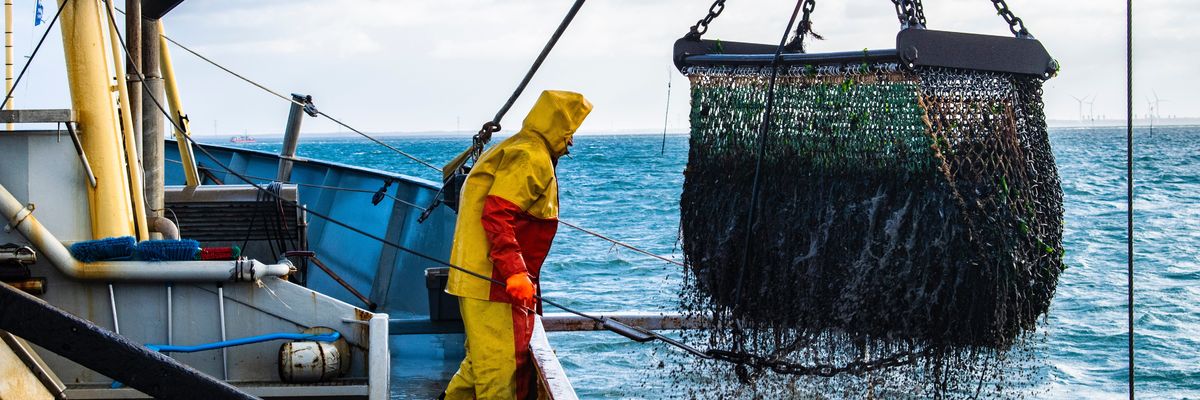Farmers neither milk cows with nets, nor harvest vegetables with rods. And fishermen neither scatter seeds in the oceans, nor catch fish with sickles.
Despite our differences, something we do share is a common threat from the expansion of industrial fish farming and big agribusiness.
More specifically, the expansion of industrial fish farming provides an increasingly profitable outlet for large-scale agriculture corporations to market surplus grains like soy and corn as “fish feed.” Such developments threaten both fishing and farming communities, as the model promotes industrial production of genetically modified monocrops for concentrated animal feeding operations on land and at sea.
According to the Food and Agriculture Organization (FAO), marine and inland aquaculture production has significantly increased around the world from 1990 to 2022, with the former growing from 12.6 to 44.7 million live weight tons, and the latter moving from 9.2 to 26.8 million live weight tons.
Factory fish farms have emerged to line the pockets of big corporations by producing monocultures of fish at mass volume, under the guise of satisfying seafood demand. This "demand" is artificially created by the fact that we currently export 75-80% of U.S. wild-caught seafood. US wild-capture fishermen landed more fish domestically than Americans consumed in 2020, according to the National Ocean and Atmospheric Administration.
The influx of nutritionally inferior farmed fish devalues sustainable and diverse wild-caught fisheries, forcing fishermen to accept pennies on the pound for hard-earned fish. Furthermore, wild forage fish, which make up the base of healthy marine ecosystems, are being harvested for incorporation into aquaculture fish feeds, along with soy and corn. These fish, specifically Menhaden and herring, are the main source of protein for every species of finfish.
Densely packed fish farms also degrade ocean ecosystems. They amount to floating feedlots that pollute waters with antibiotics and fish waste; endanger marine mammals that interact with the cages; and compromise local coastal economies that depend on fishing and tourism. From coast to coast, lobbyist-backed efforts are underway to expand this industry in the United States.
Certain large-scale agribusiness firms have jumped on the bandwagon and made offshore industrial fish farming an area of focus. In a nutshell – or perhaps a soybean – the firms together referred to as “ABCD” (Archer Daniels Midland, Bunge, Cargill, and the Louis Dreyfus Company) are developing what is known as “aquafeed.”
According to Cargill, aquafeed includes “co-products” that are “not of marine origin.” Those “co-products” include all kinds of things, including large amounts of soymeal and corn - most of which is genetically modified.
Should fish eat corn or soy? Common sense says no.
As you can imagine, fish have trouble digesting grains. On top of that, placing thousands of fish in confinement generates other issues, including disease and illness.
In response, Cargill has acquired firms, such as Diamond V, which specialize in producing feed additives to improve fish health and digestion. They are also working on new “co-products,” such as insects and algae to supplement the soy and corn that fish are forced to eat.
Notice the circle: agribusiness firms create solutions for problems they created in the first place. In fact, we wouldn’t have to worry about fish diets if they were not sick from being crammed into unnatural habitats, eating manufactured food — basically, if there were no factory fish farms.
Meanwhile, our current industrial agricultural system rests upon bailing out farmers just enough through schemes like crop insurance, so that they continue to grow excess corn and soy, regardless of demand. In fact, crop insurance has become the second largest section of the Farm Bill, the mammoth piece of federal legislation that covers programs ranging from rural development to food access to beginning farmer training. In comparison, federal agencies spend a pittance on policies that could promote diverse operations and climate solutions.
The truth is that mega-scale agribusinesses' grain merchants wouldn’t be looking to force-feed soybeans and corn to fish if we had a decent agriculture policy that supported farmer incomes and local, diversified operations, rather than crops that feed into the commodities market. Instead, soy and corn are being overproduced in the U.S. and the Global South, often on land seized from Indigenous peoples for mono-crop expansion that relies on deforestation and pesticide use.
This plays out as a perfect scenario for agribusiness giants to pad their pockets. But not so for small-scale farmers and fishermen, who don’t see any benefits for themselves or their communities.
Still, there’s hope. New proposed legislation for the currently debated Farm Bill may yield positive results, instead of more commodities in our global industrial food system.
Senator Lisa Murkowski (R-AK) recently introduced the Improving Agriculture, Research, Cultivation, Timber, and Indigenous Commodities (ARCTIC) Act, much of which is aimed at including seafood in the Farm Bill. The legislation bans offshore fish farms in federal waters, while increasing portside processing facilities for small-scale fishermen. It also calls for country of origin labeling for cooked crab that may come from outside of the US into our markets, as well as a ‘Wild USA Seafood’ label for fish that is landed in US waters.
Preventing the development of offshore factory fish farms is a win for fishing communities. But it’s also a potential win for farmers and the environment. It could deter farmers from continuing on the commodity grain treadmill, allowing them to instead diversify in search of market alternatives and better profits.
By using commodity grains produced on factory land farms to feed fish in factory ocean farms, Big Ag has brought small-scale farmers and fishermen like us together. The Farm Bill, up for reauthorization, seems like an apt opportunity for cross pollination. Why not use this important legislation to address farmers’ and fishermen’s issues together?
We hope more food producers from land and sea join in on our shared fights. After all, our farming and food systems don’t end at the water’s edge.



